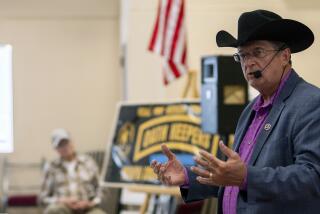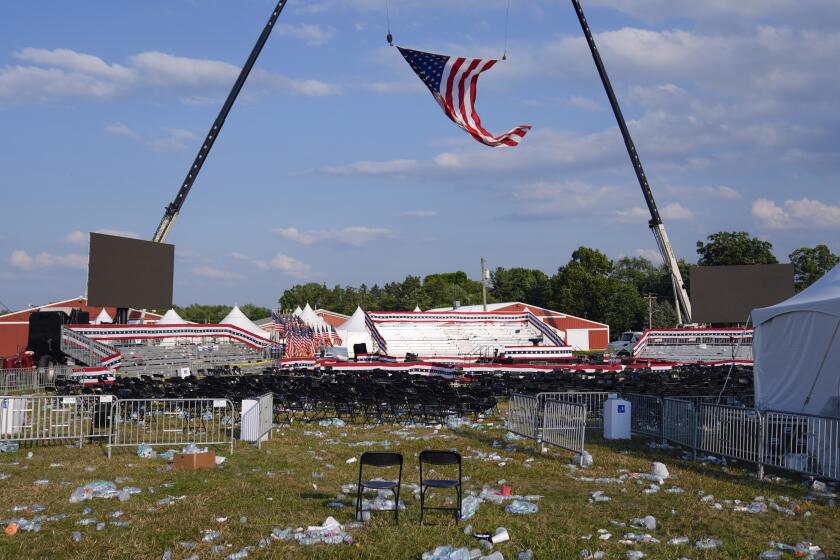Shiite pilgrims flock to Baghdad
Kadhimiya was braced for tragedy Thursday.
The last time pilgrims descended on this Baghdad neighborhood to pay their respects at the grave of the seventh Shiite imam on the anniversary of his death, snipers killed 22 of them. The year before, rumors of a suicide bomber caused a stampede that left nearly 1,000 people dead.
U.S. and Iraqi military commanders who flew to Forward Operating Base Justice in the heart of Kadhimiya warned of mortar attacks and car bombs, and cautioned that with so many pilgrims, about 70% of them women, a suicide bomber could slip through without being searched.
Iraqi commanders had 3,000 troops and police in the area, about 800 of them at the golden-domed shrine that houses the grave.
“Hopefully, all this visitation will pass in peace,” Gen. Falah Hassan Kanbar said. His worry was the same as that of U.S. commanders: The Shiite militia Al Mahdi was well established in the area, making it an alluring target for Sunni Muslim militants.
Since Tuesday, vehicles had been banned, leaving the roads to pilgrims and security convoys. U.S. forces patrolled in helicopters and Humvees at a respectful distance from the shrine.
“This is the first time that we see all this effort,” Col. Rahad Abbas said of the helicopters circling overhead. “That’s why there’s no mortar rounds.”
By 4 p.m., crowds filled the streets and highways leading into Kadhimiya, chanting and waving colored banners. Pilgrims hitched rides on buses, oil trucks and a cargo train.
The atmosphere resembled that of a street fair, with elderly men and children alike tying on shiny green headbands and toting multicolored flags. Pilgrims set up outdoor speakers to broadcast traditional chants, lighted fires to cook tureens of soup and set up tents full of soft rugs and pillows along the roadside for weary travelers.
Men at water trucks and stands doled out bottles and cups of water to the thirsty. Ambulances were at the ready to treat those suffering from dehydration or low blood pressure. Temperatures hovered around 115 degrees.
Among those grabbing some water was Mohammed Sami, 17, a high school student from the Karada neighborhood to the south. He said he was making the pilgrimage with some friends -- and his parents’ blessing -- for the third time since 2003, when the fall of Saddam Hussein enabled the Shiite majority to make the pilgrimage without fear of reprisal.
“It feels great to be able to participate in such events and to show the world that we do not fear anything regardless of the situation,” he said.
Several Iraqi officials visited the area Thursday, including national security advisor Mowaffak Rubaie and Interior Minister Jawad Bolani.
There were incidents of sporadic violence elsewhere: Gunmen attacked pilgrims and wounded three Iraqi soldiers at Qahtan Square in west Baghdad, and pilgrims crowding into a train caused its electrical system to short-circuit, killing two and injuring 15, police said.
The U.S. and British militaries reported additional casualties in a particularly deadly week: Two Marines died Tuesday in Al Anbar province, one in combat and another in a noncombat incident. A soldier died in Baghdad on Wednesday in a noncombat incident. U.S. military deaths in Iraq stand at 3,684 since the U.S.-led invasion in 2003, according to the website icasualties.org.
Two British soldiers were killed Wednesday night in a bomb blast as they patrolled southern oil fields, and a third was killed in the Basra region Monday when his vehicle was bombed. On Tuesday, a British soldier on a foot patrol was fatally shot.
But in a country so accustomed to massive violence, Thursday’s pilgrimage was a surprisingly peaceful occasion.
It was unclear whether the U.S. and Iraqi troop presence, or the ubiquitous Al Mahdi militiamen, or both, was responsible for the calm.
The rhythm of the march was disrupted by a small ripple of discord. On a road into Kadhimiya, youths in black T-shirts, a trademark of Al Mahdi, began shaking their fists at a U.S. convoy. “They’re chanting something, and they’re pointing at us,” one of the U.S. soldiers said, his voice flat and tense.
“I don’t think these people like us. Have you seen them throwing their hands up? I’m getting a string of dirty looks,” a gunner said, surveying the crowd, his weapon ready.
A small stone pinged off the Humvee. The soldiers got out. The chanting grew louder. More pilgrims shook their fists at the soldiers. Some moved in -- to within touching distance.
But the soldiers kept moving, walking deeper into Kadhimiya. So did the pilgrims. Soon the chanting stopped, and the soldiers found an Iraqi army patrol. The Iraqi soldiers approached and gave them high-fives, patting them on the back.
No violence broke out. A few people even greeted the soldiers warmly, waving and offering water.
Ali Kader came from the nearby neighborhood of Hurriya to distribute water in metal tumblers. Standing behind his table about a mile from the shrine, with passersby marching and chanting shoulder to shoulder, Kader said he was pleased to see the celebration go so smoothly, and to see the security forces.
“People come here and see how peaceful Kadhimiya is and hopefully it will reflect on the rest of Iraq,” said Kader, all dressed in traditional black. He had brought his prayer beads and planned to visit the shrine at night.
Lt. Col. Steven Miska, 39, the commander at Forward Operating Base Justice, stopped at several checkpoints Thursday to chat with Iraqi soldiers and policemen he knew. They were relieved that the celebration, which is expected to last through today, had gone well.
“Well, it’s not over yet,” Miska said. “We’ve got to get the pilgrims home.”
--
molly.hennessy-fiske@latimes.com
More to Read
Sign up for Essential California
The most important California stories and recommendations in your inbox every morning.
You may occasionally receive promotional content from the Los Angeles Times.











